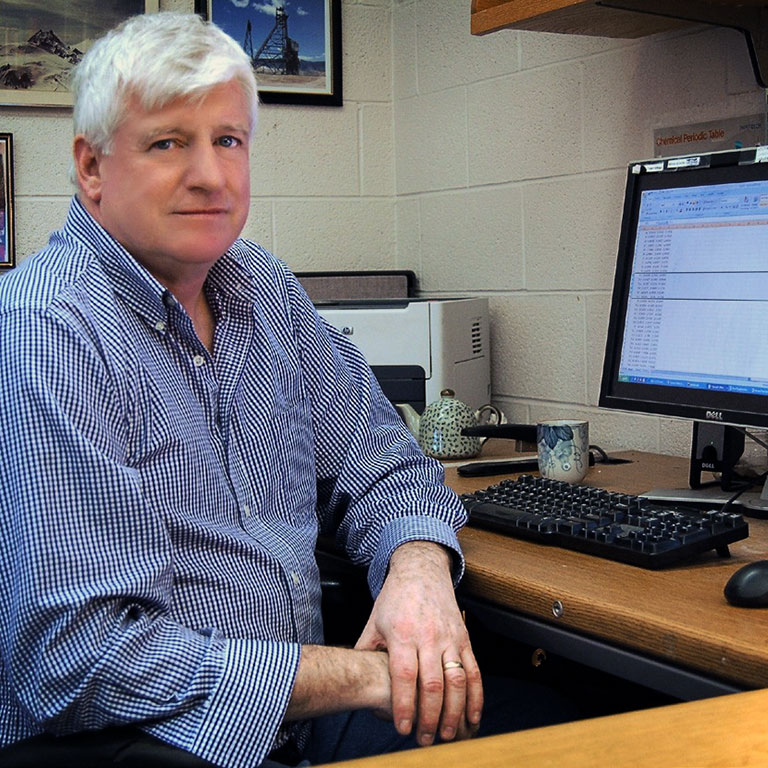- Ph.D., Johns Hopkins University, 1985
- M.Sc., Colorado School of Mines, 1980
- B.A., Amherst College, 1977

James G. Brophy
Professor Emeritus, Earth and Atmospheric Sciences

Professor Emeritus, Earth and Atmospheric Sciences
My primary research interest centers around the chemical and physical processes involved in magmatic differentiation. My work utilizes a wide range of techniques and approaches including geologic field mapping, petrologic and geochemical analysis (major and minor element geochemistry, electron micro-probe) and fluid dynamic modeling. Over the years I have had students conduct research in several areas including the Aleutian Islands, the Cascade Mountains of western Oregon and northern California, the Basin and Range province of the western U.S., and the mid-ocean ridge East Pacific Rise. These studies, largely funded by the National Science Foundation, have considered such diverse topics as the role of subducted crust in the high pressure formation of island arc basalt, the relative roles lower crustal melting, magma mixing and fractional crystallization in the formation of calc-alkaline andesitic magma, the growth and temporal evolution of low-pressure magma chambers beneath subduction-related volcanoes and, finally, the physical mechanisms of low-pressure fractional crystallization in both mid-ocean ridge and subduction zone settings. Most recently, my work has centered around: (1) the role of vapor (H2O) exsolution on the dynamics of magma ascent, crystallization and differentiation of magma; and (2) geochemical modeling of Rare-Earth Element (REE)-SiO2 systematics as a potential means of discriminating between a fractional crystallization and crustal (amphibolite) melting origin for intra-oceanic silicic magmas.
A second area of interest is one-atmosphere experimental petrology. My laboratory has several high-temperature, controlled-atmosphere gas-mixing furnaces that are available for use. Published experimental studies have involved the determination of liquid-lines-of-descent in mid-ocean ridge basalts from the East Pacific Rise; and the solubility of Cu in S-free and S-rich basaltic magmas. Current studies center around the role of crystallization rate on major and minor element partitioning between co-existing clino- and ortho-pyroxene with the ultimate goal of developing a geospeedometer to assess crystallization rates in natural magmas.
Medina, Christian (Ph.D. Candidate) Experimental investigation of fluid-rock interaction in the feldspathic Mt. Simon sandstone: Implications for CO2 sequestration in deep-seated sandstone reservoir rocks.
Pu, Xiaofei (M.S. 2012) Geochemical and petrologic evaluation of lower island arc crust partial melting in the Yakuno ophiolite, Japan.
Mukherjee, Shibashis (M.Sc., 2007) One-atmosphere investigation of the role of cooling rate on major element partitioning between orthopyroxene and clinopyroxene in andesitic magmas.
Dreher, Scott Travis (M.Sc., 1996) The origin of composition gaps at South Sister Volcano, high Cascades, central Oregon: implications for crystallization processes beneath active calc-alkaline volcanoes.
Whittington, Carla M.(M.Sc., 1996) The petrogenesis of the basalts of Round Head Volcano, Kanaga Island, Aleutians.
Webster, John Robert (Ph.D., 1992) Petrology of Quaternary volcanics of the Broken Top and Diamond Peak areas, central and south-central Oregon High Cascades: evidence for varied magmatic processes from two contrasting volcanic centers.
Stewart, Michael A. (M.Sc., 1992) Petrogenesis of high alumina flood basalts, Steens Mountain, Oregon.
At the departmental level, I am in charge of the rock preparation lab and am a member of the undergraduate committee. At the national level, I am a regular reviewer of national and international journals, and a grant reviewer for both the Earth Science and Ocean Science divisions of NSF. At the international level, I am a panel member for the Science Foundation of Ireland (SFI) Earth Sciences program.